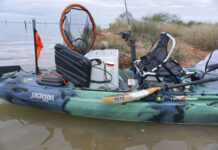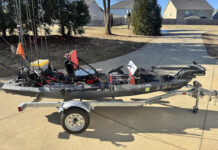Ispend most of my time on the water targeting striped bass and bluefish using big live bait. The bait of choice is menhaden, also called a pogy. These bait fish average 12–15 inches in length, which can make it pretty tough to keep them alive on a kayak. To solve this problem, I built a homemade bait tube out of PVC pipe from my local hardware store. Follow these six easy steps to build your own DIY live bait tube.
Looking Into Live Bait Tubes
Live bait adds a few complications to your fishing setup, but it’s easy to store little minnows in your kayak’s tankwell. For larger live bait, it gets more complicated. I set out to find a way to keep them alive while not cluttering up my kayak. In my search, I stumbled across people who were using PVC tubes with holes drilled into them to keep all sorts of bait alive.

I saw some tubes as short as 12 inches—used for minnows and shrimp—and others over three feet in length. After careful consideration, I opted to construct a two-foot-long bait tube. The next decision was what diameter PVC pipe to use. Most of the people using them for menhaden and other big baits went with 4-inch diameter, so that’s what I chose.
Overall, this bait tube has worked great. It has kept up to ten live menhaden alive for around five to six hours. I also used it to keep live mackerel and it worked just as well. It was pretty easy to make and only cost about 30 dollars for the materials needed.
DIY Bait Tube Materials
- 4” PVC pipe cut to desired length
- 4” PVC cap
- 4” PVC female adapter
- 4” PVC male threaded cap
- 5/8” drill bit used for drilling the holes in the bait tube
- 1/2” drill bit used for drilling holes in both caps
- 1/4″ drill bit used for drilling holes to attach paracord and for zip ties
- Paracord
- 2 carabiners
- Pool noodle
- Zip ties
- PVC primer and cement
6 Steps to Build a DIY Live Bait Tube
1 Cut pipe to length and perforate
The first step is to cut your PVC to the desired length. Then, use your 5/8” drill bit to drill holes along the length of the tube all the way around. Use the 1/2″ drill bit to drill holes in both end caps.

2 Tether the cap to your tube
Use the 1/4″ drill bit to make a hole in the center of the male threaded cap as well as the end of the tube closest to the male cap. Thread a piece of paracord through the male cap and secure it with a knot on the inside. Do the same in the 1/4″ hole drilled at the end of the tube. This will keep you from losing the cap when it’s unscrewed.
3 Attach a short leash for fighting fish
Drill a 1/4″ hole through the center of the other cap. Thread a 8” piece of paracord through this hole and secure it on the inside with a knot. Attach a carabiner to the other end of the paracord. This will be used when you are fighting a fish and you need to keep the tube close to you to avoid the fish getting tangled with the tube.
4 Attach a longer leash to use in transit

Next, drill another 1/4″ hole on the same end. Place this hole at the very far end of the PVC pipe close to the edge of the flat cap. Thread a piece of paracord through this hole and tie a knot in the end to secure it on the inside. Make this piece of paracord long enough to allow the end of the tube with the threaded cap to just reach the back of your kayak. Attach a carabiner to the end of the paracord.
5 Add a float so it stays upright
Drill 1/4″ holes along the length of the PVC pipe lined up with the last 1/4″ hole you drilled. These holes will allow you to attach a section of pool noodle to the bait tube with zip ties. Position the pool noodle directly over these holes and line it up with the hole you drilled for the paracord. This will assure the tube will float upright while you are paddling, and will create much less drag.
6 Affix the caps
Finally, prime and glue the end cap and the female adapter into place. Screw on the male threaded cap and you’re done!
How to Attach the Bait Tube to Your Kayak
Attach the tube however you like. If you have a paddle kayak I recommend attaching it at one end with the carabiner and towing the tube behind you. This will keep it out of the way of your paddle. You can also make a quick modification and add attachment points at both ends to hang it from the side of your kayak.
How to Use the Bait Tube
Add bait to the tube head-first from the end with the threaded cap. This will allow them to face forward, toward the direction you are paddling. Now get out and catch some fish!
A DIY live bait tube lies on the garage floor, ready for action. | Feature photo: James Chappel







The black ABS pipe in my experience works better than PVC because it is naturally buoyant, and it is less brittle, more impact resistant than PVC. It also costs a few cents less per foot.